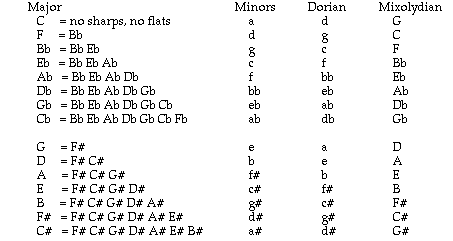|
|
and SCALE FORMULAS |
|
|
If you arrived here because some of this "music theory" interests you, you might want to explore some of the music theory software that we have at school. Let me know and I will get you started. --MsM Included on this page are: |
|
According to the Harvard Dictionary of Music*, a half step (or semitone) is "one-half of a whole tone, the smallest interval in traditional Western music. ... The octave consists of twelve semitones and the diatonic scale includes two semitones." (The major scale and the natural minor are diatonic scales.) Click here for some scientific information about half-steps. 
return to scale page return to top of this page What is an Interval Formula?Scales are built on interval formulas. Diatonic scales use only half steps and whole steps. When you get into the harmonic minor, melodic minor, blues scales & some of the "ethnic scales" like the Ahava Raba mode used in Klezmer music, then you run into scales that have whole steps, half steps, a step and a half, and more. The first note of the scale is called its root:
Using white keys only, a major scale starting on C has no sharps and no flats. Look at the keyboard and see that this scale follows the whole step / half step pattern of root, whole step, whole step, half step, whole step, whole step, whole step, half step 
Major scale formula: R, W, W, H, W, W, W, H Now, if you will use the keyboard and make a major scale starting on D, you will find that in order to key the whole step, half step pattern, you need to add an F# and a C#. Look at a key signature chart and you will see that is correct! This is how key signatures are arrived at - it really isn't just random! Try figuring out a few major scales using the keyboard, then check the key signature chart to see if you were correct. Try these:
return to scale page return to top of this page Scale Formulas
|
|
return to scale page return to top of this page Diatonic ScaleA diatonic scale is one that has no added sharps or flats other than what is in the key signature -- the scale's interval pattern could be played using only the white keys on the piano. Diatonic scales are the major scales, natural minor scales (not the harmonic or melodic, because they add sharps!), dorian, mixolydian and all of the other so-called "Church Modes". return to interval formulas |
|
ScienceAgain, quoting from the Harvard Dictionary of Music, "The exact measurement of a semitone (halfstep) varies slightly according to the system of tuning. In equal temperament, each semitone equals exactly 100 cents." --- Eeeek!! What are some of these words???
So why have equal temperament?? Early in the history of keyboard instruments the player had to retune the harpsichord for each key -- in the key of C, an E was the third, but if we switched to the key of D, the E is now the second and needed to be tuned differently. Equal temperament was invented as a means of averaging out the difference and making everything just a little out of tune and a little in tune. Our ear gets used to this tuning and it works fine. |
|
return to halfstep / wholestep return to scale page return to top of this page * Apel, Willi. Harvard Dictionary of Music, second edition. Cambridge, MA: Belknap Press of Harvard University Press, 1972. page 762. |
Key Signature Chart
Click here to go to a page with a key signature chart that will print out quickly. |
|
Visit the Wayland Public Schools site http://www.wayland.k12.ma.us |
|||
|
|||
|
|||
|
|||
|
|||
|
|
|||

